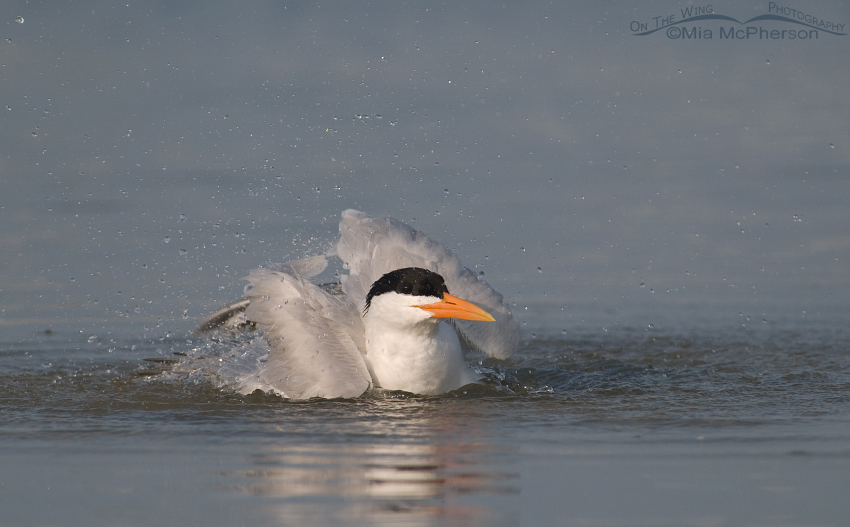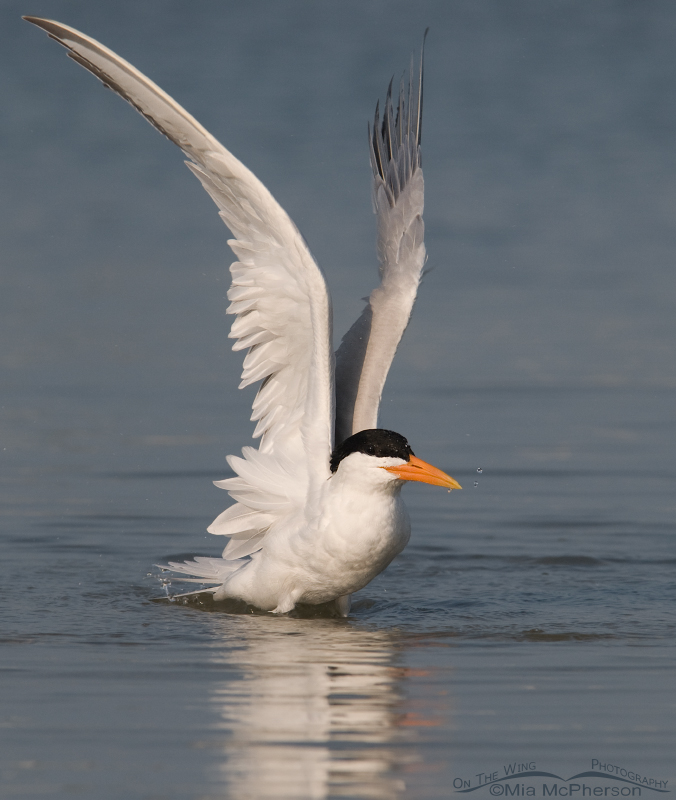 Bathing Royal Tern – Nikon D200, handheld, f6.3, 1/1250, ISO 250, Nikkor 80-400mm VR at 400mm, natural light
Bathing Royal Tern – Nikon D200, handheld, f6.3, 1/1250, ISO 250, Nikkor 80-400mm VR at 400mm, natural light
These two bathing Royal Tern images remind me of the warm April morning when I spent time photographing different species splashing around in the Gulf of Mexico. It seemed like one bird started it all by splashing around and soon there were Royal Terns, Laughing Gulls and Black Skimmers all splashing about in the warm, salty waters at low tide. I couldn’t resist laying down in the wet sand to get some nice low angle shots of the bathing birds.
 Wings up… – Nikon D200, handheld, f6.3, 1/1250, ISO 250, Nikkor 80-400mm VR at 280mm, natural light
Wings up… – Nikon D200, handheld, f6.3, 1/1250, ISO 250, Nikkor 80-400mm VR at 280mm, natural light
This Royal Tern spent quite a bit of time dipping itself under the shallow water and splashing around before raising its wings and shaking off the water droplets before flying off to the sand to preen itself.
All the terns in North America have ebony black eyes that can be difficult to see when they are in breeding plumage because of their black caps and that makes it challenging for bird photographers to capture just the right moment for the catch lights to show and accentuate their eyes.
Life is good.
Mia


If who you’re referring to is who I think it might be, his playing around with imagesmmakes them look oversaturated and artificial,…sometimes what he does with the eyes makes the birds look crosseyed and makes me feel dizzy….
It probably is Patty. And I agree with your assessment!
And you have captured the only Royal bath I have any interest in seeing. Thank you. So very much.
My pleasure EC.
I think I know who you’re referring to and in many instances I would tend to agree with you. He does much more post processing than you do, but where a person draws the line is a matter of choice based on what final product a person desires. Personally if it looks like “post” to me I know I’ve gone too far, but those sliders and tools are hard to let go of sometimes. What’s interesting to me is that I never heard any such controversy back when I worked in labs with exotic chemical and every trick I could think of to nudge out a better image. Even Ansel Adams took some of his old negative back to the lab and produced startlingly different and much more dramatic results that almost everyone loved. I think because post processing is so easy now it’s become somewhat suspect.
And by the way Mia – I think your camera fieldwork is second to none and a benchmark for all serious wildlife photographers, and I think you achieve that through your remarkable dedication to the craft and to you subjects.
M. Bruce, I do agree that where a person draws the line concerning post processing is a matter of choice but I also believe that when an image is intentionally altered drastically in post processing beyond what it looked like originally in the camera that it should be disclosed. I think that post processing in the digital age has far surpassed what we used to do in film days.
Thank you so much for you very kind words on my work, I love my subjects and hope that shows in my work.
I really enjoyed your superb photographs of the Terns, Mia! Didn’t you just feel like rolling on over into the surf and splashing, too? I’m gonna do that one day and just hope I remember to put the camera stuff somewhere dry first……
Thanks Wally. I really liked terns. I do feel like rolling over into the surf and splashing too. And there were plenty of times the surf splashed upon me. I was always nervous about my camera getting wet but it never happened.
It’s horrible and very sad … but I am happy that I can watch your beautiful photos. Thank you Mia
Thank you Jolanta.
I must admit I posted these images to help flush a very bad image out of my mind of Royal Terns I saw yesterday on line where a guy who has a reputation for cloning things into his bird images without admitting that he has done extensive manipulations had cloned fake eyes onto his Royal Tern image. Those fake eyes looked like silver sequins glued onto a live bird. Horrible. Really horrible.